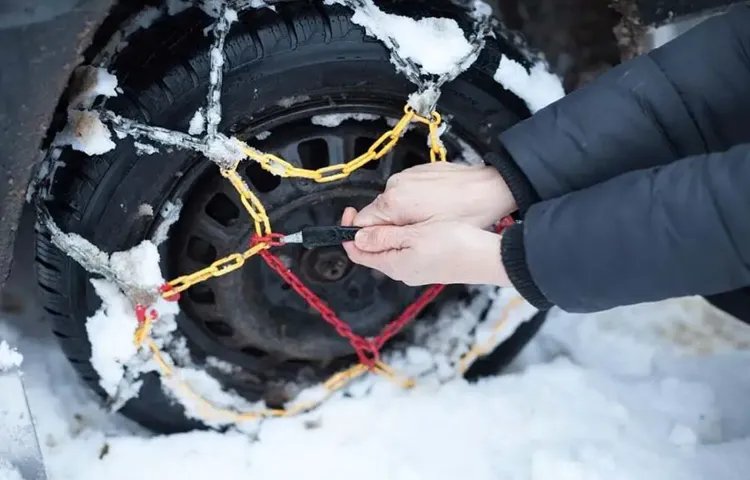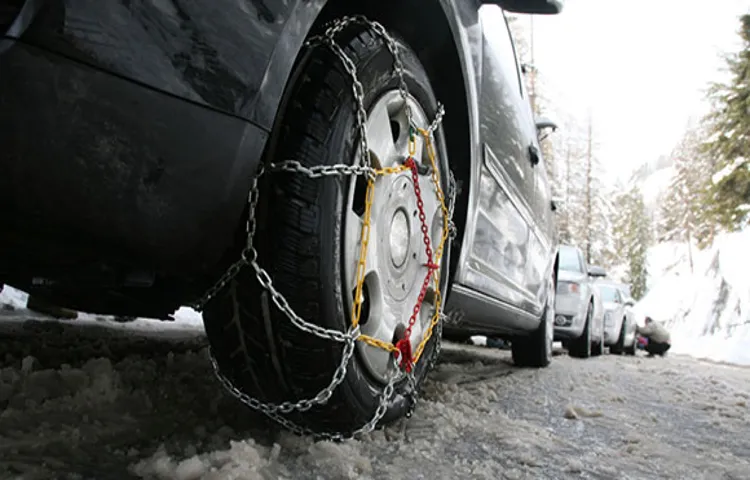Driving on snowy or icy roads can be a nerve-wracking experience. The fear of skidding or getting stuck can make even the best drivers feel uneasy. One way to ensure your vehicle’s safety is by using tire chains.
But how many tire chains do you need? It’s a common question that puzzles many drivers. In this blog post, we will answer this question and provide some tips on how to choose the right tire chains for your vehicle. So, buckle up and let’s get started!
Table of Contents
Understanding Tire Chains
If you’re wondering how many tire chains you need, the answer largely depends on the type of vehicle you have and the driving conditions you’ll be facing. For passenger cars, it’s usually recommended to use chains on just two of the wheels (either the front or rear) to improve traction in snow and ice. However, for larger vehicles like trucks and SUVs, it’s often necessary to use chains on all four wheels for optimal grip.
Additionally, some roads may have specific requirements for tire chains, so it’s important to check local laws and regulations before hitting the road. Ultimately, the goal of using tire chains is to improve safety and control in challenging driving conditions, so it’s always better to err on the side of caution and use more chains than you might think necessary.
Types of Tire Chains
When it comes to driving on snowy or icy roads, having the right set of tire chains can make all the difference in your safety and peace of mind. But with so many options available, it can be challenging to know which type of tire chains to choose. The most common types of tire chains include cable chains, ladder chains, and diamond chains.
Cable chains are the lightest and easiest to install, making them a popular choice for occasional use. Ladder chains provide more traction and can handle heavier vehicles, while diamond chains are the most aggressive and suitable for extreme winter conditions. When selecting tire chains, it’s essential to consider your vehicle’s size and weight, the type of driving you’ll be doing, and the conditions you’ll encounter.
Ultimately, investing in quality tire chains can help you stay safe while driving in challenging winter weather conditions.

Benefits of Using Tire Chains
Tire chains are an essential accessory to have during winter driving conditions. They provide numerous benefits that drivers cannot afford to overlook. Tire chains excel at providing extra grip and traction on snowy, icy or slippery roads.
You wouldn’t want to get stranded or lose control while driving on treacherous roads. Tire chains ensure that your vehicle remains stable and secure, allowing you to drive without fear of skidding. Tire chains can also help extend the life of your normal tires by not allowing them to bear the entire weight of your vehicle while driving on the terrain covered with snow.
Additionally, tire chains are essential for drivers who are on steep hills or mountainous regions where the roads are more challenging to drive on. They provide an additional layer of safety for drivers navigating difficult roads. Driving with a set of tire chains installed is essential for those who want to avoid accidents and reach their destination safely.
Determining the Right Amount of Tire Chains
If you are planning to use tire chains for your vehicle, one common question that might come to your mind is “how many tire chains do I need?” The answer depends on various factors like the type of vehicle you have, the tire size, and the conditions of the road you’ll be driving on. Generally, you only need chains on the drive wheels of your vehicle (either front, rear, or all wheels depending on the type of drivetrain). However, some situations might require the use of chains on all four wheels.
It’s important to measure your tire size to ensure that you purchase the right size chain. If you’re driving in deep snow or on steep hills, you might need more chains to ensure better traction. Nevertheless, it’s always a good idea to carry an extra set of chains just in case one breaks or malfunctions.
Overall, the key is to check the manufacturer’s recommendations and local laws to determine how many tire chains you need for your specific circumstances.
Factors to Consider
Determining the right amount of tire chains for your vehicle can be a tricky task. There are several factors to consider before making a decision. Firstly, you need to consider the type of vehicle you have, as this will ultimately determine how many chains you need.
For example, a larger vehicle like an SUV or truck will require more chains than a smaller vehicle like a sedan. Secondly, you need to consider the weather conditions you will be driving in. In snowy or icy conditions, you will need more chains to ensure proper traction and safety.
Lastly, you need to consider the terrain you will be driving on. If you will be driving on steep inclines or rough terrain, you may need more chains to ensure stability and control. Ultimately, determining the right amount of tire chains requires careful consideration of these factors to ensure your safety on the road.
Calculating the Number of Tire Chains Needed
When it comes to driving in snowy or icy conditions, tire chains can provide much-needed traction and control. However, determining the right amount of tire chains to use can be a bit confusing. To calculate the number of tire chains needed, start by checking the vehicle’s owner’s manual, as it may have specific recommendations.
Next, count the number of drive tires – the tires that get power from the engine. For most vehicles, this will be either two or four tires. Then, decide whether to use chains on all drive tires or just one set (front or back, depending on the type of vehicle).
Finally, purchase the appropriate number of chains based on the number of drive tires and the desired amount of coverage. It’s important to note that some states have specific laws regarding the use of tire chains, so be sure to research local regulations before hitting the road. By following these steps, drivers can feel confident that they are using the right amount of tire chains for their vehicle and the driving conditions.
Proper Installation and Maintenance of Tire Chains
If you’re wondering how many tire chains you need for your vehicle, the answer is that it depends on the type of vehicle you have. It’s important to read the owner’s manual or speak to a professional to determine the correct number of chains you need. Improper installation or mismatched chains can cause damage to your tires or even cause accidents on the road.
Once you have the correct number of chains, it’s important to properly install and maintain them. Make sure the chains are tight and secure on all four wheels and that they don’t drag on the ground. After driving in snowy or icy conditions, it’s also important to remove the chains and clean them to prevent rust and damage to your vehicle.
Taking the time to properly install and maintain your tire chains can greatly improve your safety on the road during winter weather conditions. Remember, safety always comes first!
Installation Tips
Tire chains are an essential accessory for any vehicle operating in harsh weather, from snow to ice. However, proper installation and maintenance are crucial to ensure user safety and maximum performance. When installing tire chains, it’s vital to read the manufacturer’s instructions carefully and select the right size based on your vehicle’s tire size.
Start by laying the chains flat and unrolling them on the ground, aligning them with the tire tread. Place the chains on the tire and adjust them to remove any excess slack. Next, drive slowly and carefully to verify that the chains are securely in place.
Check the chains regularly during use and tighten them as necessary. When the season is over, clean the chains to remove any dirt or debris before storing them. With proper installation and maintenance, tire chains can provide the extra traction needed to navigate any icy or snowy terrain, ensuring that you get to your destination safely and comfortably.
Tire Chain Maintenance
Tire chains are a useful tool for any driver who frequently travels on snowy or icy roads, but they require proper installation and maintenance to work effectively. Before installing tire chains, it is important to check the owner’s manual for instructions specific to your vehicle. Once installed, the tire chains should be checked periodically for tightness and wear.
It is also important to drive at a slower speed and avoid sudden movements while using tire chains. After use, the tire chains should be removed promptly and cleaned of any dirt, salt or debris to prevent rust. Proper maintenance of tire chains can prolong their lifespan and ensure that they work effectively when needed.
So next time you drive on snow or ice, make sure your tire chains are properly installed and maintained for a smoother and safer trip.
Conclusion
To answer the age-old question of ‘how many tire chains do I need,’ let’s think of it like this: It’s like asking how many cups of coffee you need to stay awake for an all-nighter. It ultimately depends on the situation and individual preference. However, it’s better to have too many tire chains than not enough when driving through winter conditions.
So, stock up and keep those wheels spinning safely!”
FAQs
1. How do I know what size tire chains to get? A: You can check your vehicle’s owner manual or look up the tire size online to determine the appropriate chain size. 2. Are tire chains legal to use in all states? A: No, some states have restrictions or bans on the use of tire chains. Be sure to check your state’s laws before purchasing chains. 3. Can I use tire chains on all types of vehicles? A: No, not all vehicles are designed to use tire chains. Check your vehicle’s manual or consult a mechanic before using chains. 4. How do I properly install tire chains on my vehicle? A: Follow the instructions provided with your specific tire chains. In general, you will need to wrap the chains around the tires and secure them tightly. 5. Do I need to remove my tire chains before driving on pavement? A: Yes, driving on pavement with tire chains can damage both the chains and the road surface. Only use chains when driving on snow or ice. 6. Are there any alternative options to tire chains for winter driving? A: Yes, options such as winter tires, all-weather tires, or even sandbags for added traction can help with winter driving. 7. How long do tire chains typically last? A: Tire chains can last for several winter seasons if properly maintained and used only when necessary. However, harsh conditions or improper use can shorten their lifespan.



